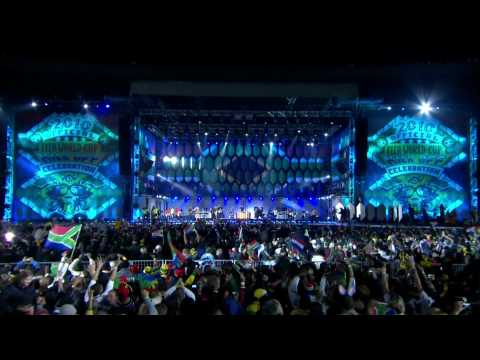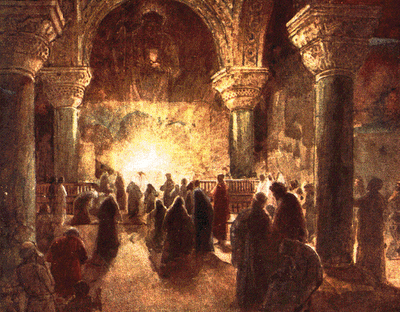The Proto-Mass: The Road to Emmaus
 I came across this very cute little video…
I came across this very cute little video…
"We are travellers…not yet in our native land" – St. Augustine
 I came across this very cute little video…
I came across this very cute little video…

Many say that they weren’t being fed. In all honesty, however, many of them would have to admit they weren’t being entertained, or made to feel special, or welcomed warmly enough after Mass. They grumble and they complain.
I know what I’m talking about. I know the pressure of having to bring in a better singing group next month than the one that visited last month. I know what would happen if my preaching ever weakened or if my smile wasn’t natural enough: People would leave and go find a better preacher, a more exciting worship experience, more comfortable pews, or more programs for the kids. I know this for a fact.
– Jeff Cavins, “I’m not being fed!”
The third chapter of Dr. Barber’s book he discusses the relationship between the Book of Revelation and the Catholic Liturgy. It is a brief review of the the material covered in another excellent book by Dr. Hahn’s book, The Lamb’s Supper.
Dr. Barber begins by noting that no other apocalyptic book of antiquity relies quite so heavily on liturgical imagery as the Book of Revelation. In John’s book we find many things extremely familiar to a Catholic who attends Mass: Sunday worship, priests, vestments, incense, chalices, angels, saints etc.
In fact, the book of Revelation has profoundly impacted Christian liturgy and architecture throughout the centuries. For example, the celebrant’s chair is symbolic of the throne of God, and the surrounding chairs like those of the “elders” (Revelation 4:4).
This final book of the Bible is even divided into three parts which each have parallels with the sequence of the Catholic liturgy:
1. Penitential Rite
The early section of Revelation concerns seven letters which call the Church to repentance.
2. Liturgy of the Word
Later, a book is opened which brings about judgement.
3. Liturgy of the Eucharist
The book ends with the Church being united to Christ in the supper of the Lamb.
But why use liturgical imagery? Revelation uses liturgical imagery because the Eucharistic celebration is the way the Lord comes to His Church. Dr. Barber points out that the Greek word “parousia” which is used to refer to the Lord’s “coming” actually has the primary meaning of “presence”. Upon hearing this fact, every Catholic immediately thinks of the Eucharist and Jesus’ real presence in the Sacrament.
“Every Eucharist is Parousia, the Lord’s coming” – Cardinal Ratzinger
Today I’d like to talk a little bit about Jesus’ Real Presence in the Eucharist.
A little a while ago I was conversing via email with a non-Catholic called Gerry. We spoke briefly about the Eucharist and he graciously agreed to allow me to post some of our conversation here. Here’s what he said:
“And the mother of it all, in my opinion, is the Eucharist. Transubstantiation. Utterly abominable. Christ was a “victim” once and it was sufficient forever!
The mass is as unholy as a thing can be. We eat His flesh and drink His blood in the spiritual sense, not literal. And to think they even bow down and worship and kiss that cracker because it is (supposedly) Christ in the flesh. And God won’t judge these abominations?!” – Gerry, Email #2
I’m not going to offer a complete defense of the Eucharist here, many other more capable than I have done that already. Instead, today I’d just like to ask a couple of questions concerning one Scripture passage and then on Friday to take a brief look at Christian history.
Below is part of the “Bread of Life” discourse given by Jesus in John’s Gospel:
I am the living bread that came down from heaven. Whoever eats this bread will live forever. This bread is my flesh….Very truly I tell you, unless you eat the flesh of the Son of Man and drink his blood, you have no life in you. Whoever eats my flesh and drinks my blood has eternal life, and I will raise them up at the last day. For my flesh is real food and my blood is real drink. Whoever eats my flesh and drinks my blood remains in me, and I in them. – John 6:51-54
There are two main questions I’d like to raise here:
1. How did Jesus’ audience understand Him?
After giving this sermon, many people who had been following Jesus left Him. Why did they leave? It’s because they took Him at His word! They believed that He was saying that they had to actually eat His flesh and drink His blood.They took his words literally!
Souls were lost that day because they assumed Jesus wasn’t speaking metaphorically. This begs the question: if Jesus was speaking figuratively, why did He allow so many to leave Him over a something that was just a misunderstanding? Would God really be that cruel?
2. What would He have had to say if He wanted to speak literally?
When speaking with people who interpret John 6 figuratively, I propose the following thought experiment. Firstly, I assume that they are correct in their interpretation of John 6. Jesus was speaking figuratively. However, I then offer the following challenge: if you wanted to go back and alter John 6 to make Jesus speak literally about His flesh, what would you change? Or, put another way, if Jesus had wanted to speak of his flesh literally, what could He have said to convince you that he was speaking literally and not figuratively? I mean, how could His language have been any more extreme than “my flesh is real food“?
So that’s an extremely brief look at John 6. On Friday we’ll look at the Christian witness of the Eucharist in the first two centuries.

The article Real Food, Real Drink first appeared on RestlessPilgrim.net
 Do Catholics know the Bible?
Do Catholics know the Bible?
I remember the first time I heard the Bible at Mass. By that, I don’t mean the first time I heard a Reading from Scripture in the Liturgy of the Word. No, I’m referring to the first time I heard some words from the lips of the priest and thought to myself “Hey, that’s straight from Scripture”.
Now, I knew some of the more prominent features of the liturgy such as the Gloria, Sanctus and Kyrie came from Scripture, but I thought that was pretty much it. It turns out I was very wrong…
So when was the first time I “heard the Bible at Mass”? Well, I was an altar server and went to wash the priest’s hands prior to the Eucharistic prayer. The priest came forward and, as I poured water over his hands, he said the words “Lord, wash away my iniquity and cleanse me from my sin”. I recognized those words! I had been reading through the book of Psalms at the time and recognized the verse from Psalm 51:
Wash away all my iniquity
and cleanse me from my sin – Psalm 51:2
Sound familiar? 🙂
After that experience, I began to pay closer attention to the words of the Mass. Again and again I found that virtually everything that was said came from Scripture. In fact, now whenever I have non-Catholic Christians attend Mass with me, I invite them to keep a tally of the number of Scripture quotations or Biblical allusions they hear.
So do Catholics know the Bible? Well, maybe better than they think…
 Today is the Feast of “All Saints” and a Holy Day of Obligation.
Today is the Feast of “All Saints” and a Holy Day of Obligation.
“Holy Day of Obligation? That’s like telling me that I must have some bacon with this salad!”